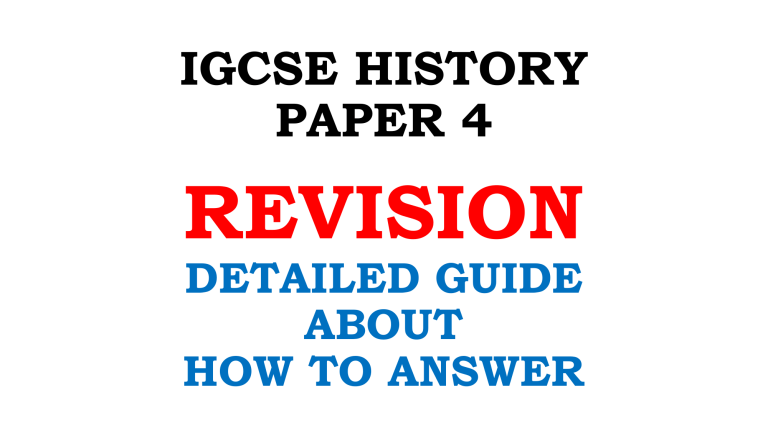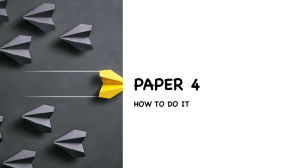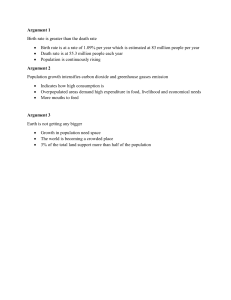
IGCSE HISTORY PAPER 4 REVISION DETAILED GUIDE ABOUT HOW TO ANSWER INTRODUCTION • Paper 4 is a one-hour exam. • The chosen depth study is Germany 1918-1945. • The period starts in 1918, after the signing of the Armistice on 11/11/11am. • The period ends in 1945, when the World War 2 was over. • DO NOT MIX THE QUESTIONS, ALWAYS GO FOR DEPTH STUDY B - GERMANY!!! • According to the examiner reports, over 80% of responses are on Germany (Depth Study B), followed by the USA (Depth Study D) and Russia (Depth Study C). LEVEL 0 LEVEL 2 LEVEL 3 LEVEL 4 LEVEL 5 PURPOSE OF PAPER 4 • To meet two objectives: • How well you can RECALL, SELECT, ORGANISE, DEPLOY DETAILED AND SPECIFIC KNOWLEDGE of your chosen study • How well you can CONSTRUCT A BALANCED HISTORICAL EXPLANATION using contextual knowledge of the topic. • This might sound very complicated and difficult but this paper is just an EXTENDED VERSION OF POINT C, PAPER 1 (the 10 marks question). HOW TO START • Open your exam paper and choose the depth study you recognise from your class time, in our case Germany. • Just because you’ve watched a documentary on Prohibition or Russian Revolution, doesn’t mean you are an expert in USA and Russia Depth Studies!!! • You will find 2 questions in your Depth Study section, from which you CHOOSE ONE TO ANSWER!!! • The examiner’s report raise the concern that some students didn’t follow this simple instruction and instead answered both questions. DON’T MAKE THIS MISTAKE!!! CHOOSE WISELY • Choose wisely as THIS SINGLE QUESTION WORTH ALONE 27% OF YOUR TOTAL IGCSE GRADE!!! • Make sure you read the question, focusing on SPECIFIC TERMS INCLUDED IN THE TEXT QUESTION and in any DATES GIVEN! • Some of the questions will give you specific timings, such as 1920’s or after 1934. • You must be sure that all your examples are from that specific period only!!! Anything outside these dates is irrelevant and it won’t gain you any marks. BALANCED RESPONSE AND PLANNING • Remember that THE QUESTION REQUIRES A BALANCED RESPONSE!!! • In addition to the factor given, you must ensure that you have enough knowledge of other factors, to be able to provide a sufficient counter-argument. • PLANNING IS VITAL! • This is because you have to focus closely to one question for one full hour. • DRAW A COMPARATIVE CHART! • You have to write evidence and examples of the both sides of the argument! You can also refer back to the chart as you progress with your answer. THE NEED TO BE ANALYTICAL • BE ANALYTICAL, RATHER THEN NARRATIVE! • Remember that these are questions about IMPORTANCE or SIGNIFICANCE! • Therefore, you have to be able to explain HOW OR HY THE EXAMPLES YOU CHOOSE TO PRESENT WERE SIGNIFICANT OR IMPORTANT to the topic of your choice. • EG. If you answer a question like “The importance of the SS in securing Hitler’s control over Germany” you need to give a variety of examples about what the SS did. After that, you have to show how these actions helped to secure Hitler’s control (how many people your factors affected, or how widespread an issue was). • AS I TOLD YOU SO MANY TIMES, MAKE SURE THAT EVERY POINT REFFERS BACK TO YOUR MAIN QUESTION!!! TIPS • DON’T JUST TELL THE FACTS! • MAKE THE FACTS RELEVANT TO THE QUESTION! • Some of the examiners are clear in saying that some responses provide general comments or lists that do not address the issue and the question in hand! • AGAIN, ANSWERING THE QUESTION ANALYTICALLY IS VITAL! • MAKE SURE YOU INCLUDE SOME BALANCE! EXAMPLE • Coming back to the question about “The importance of the SS in securing Hitler’s control over Germany” you need to EXPLAIN THE THINGS THAT THE SS DID TO SECURE HITLER’S RULE! • You also have to be able to understand that there were OTHER REASONS THAT HITLER WAS ABLE TO SECURE HIS RULE. • This Paper 4 require a detailed knowledge of the content, as you are not provided with any extra piece of information, other than the question! • That’s why this is called DEPTH STUDY!!! THE BEST ANSWER! • The examiners report states that the best answers made supported answers and conclusions, with a sustained line of arguments! • That means that your opinion about the question should closely match with the evidence presented! • Do not write an long and solid argument about the role of the SS and then write in the conclusion that Nazi propaganda was more significant! • YOU CAN ONLY REACH A CONCLUSION IF YOUR EVIDENCE GOES INTO THAT DIRECTION! • USE THE PLANNING TIME BEFORE STARTING WRITING THE ANSWER TO THINK THROUGH YOUR ARGUMENT AND TO DETERMINE THE CONCLUSION!!! MISTAKES TO AVOID IN PAPER 4 • Description and narrative instead of explanation and judgement. • Disorganised answers lacking a logical flow. • Answers lacking in detailed knowledge and precise examples. • Explanation that is not developed. • One-sided, or uneven, answers. • Not thinking carefully about what the question is asking and deciding on what the answer is going to be before starting to write it. • Writing down everything they know about a topic without directly answering the question. • Judgements that lack support, explanation and argument. TIPS TO BE SUCCESSFUL IN PAPER 4 • Plan. Plan . Plan. Spend at least 10 minutes planning what you will write. Make a brief plan as shown in the model answers. • Analyse the question carefully - are their dates or quantifiers? • Use dates/statistics and specific examples. • Always give both sides to an argument - Cambridge will never ask a question that is completely one-sided. • Keep your introductions brief! A few sentences is all you need. • Remember to link your conclusion back to the question - directly answer the question - how important/significant. • Proof read your essay when you have finished - check for factual errors. • Don’t just retell sections from the topic - explain the link and causality between events. TIMMING 0-10 MINUTES 10-55 MINUTES 55-60 MINUTES READ THE QUESTIONS BRAINSTORM PLAN WRITE YOUR ANSWER PROOF READ CONCLUSION – TO PERFORM WELL 1. SELECT YOUR QUESTION CAREFULLY 2. ENSURE YOU HAVE A DETAILED KNOWLEDGE OF THE SPECIFIC TERMS AND THE TIMEFRAME 3. PLAN YOUR ANSWER 4. NOTE EVIDENCE YOU WANT TO USE ON BOTH SIDES OF THE ARGUMENT 5. CREATE A TWO-COLUMN CHART WHERE YOU LIST EVIDENCE THAT SUPPORT THE QUESTION AND LIST OTHER FACTORS ON THE OTHER. 6. ANSWER THE QUESTION. 7. USE SPECIFIC AND DETAILED EVIDENCE TO BE LINKED DIRECTLY TO THE QUESTION. 8. STRUCTURE YOUR WORK IN PARAGRAPHS. 9. PRESENT A BALANCED ARGUMENT WITH JUDGEMENTS THAT REFLECT THE EVIDENCE.





